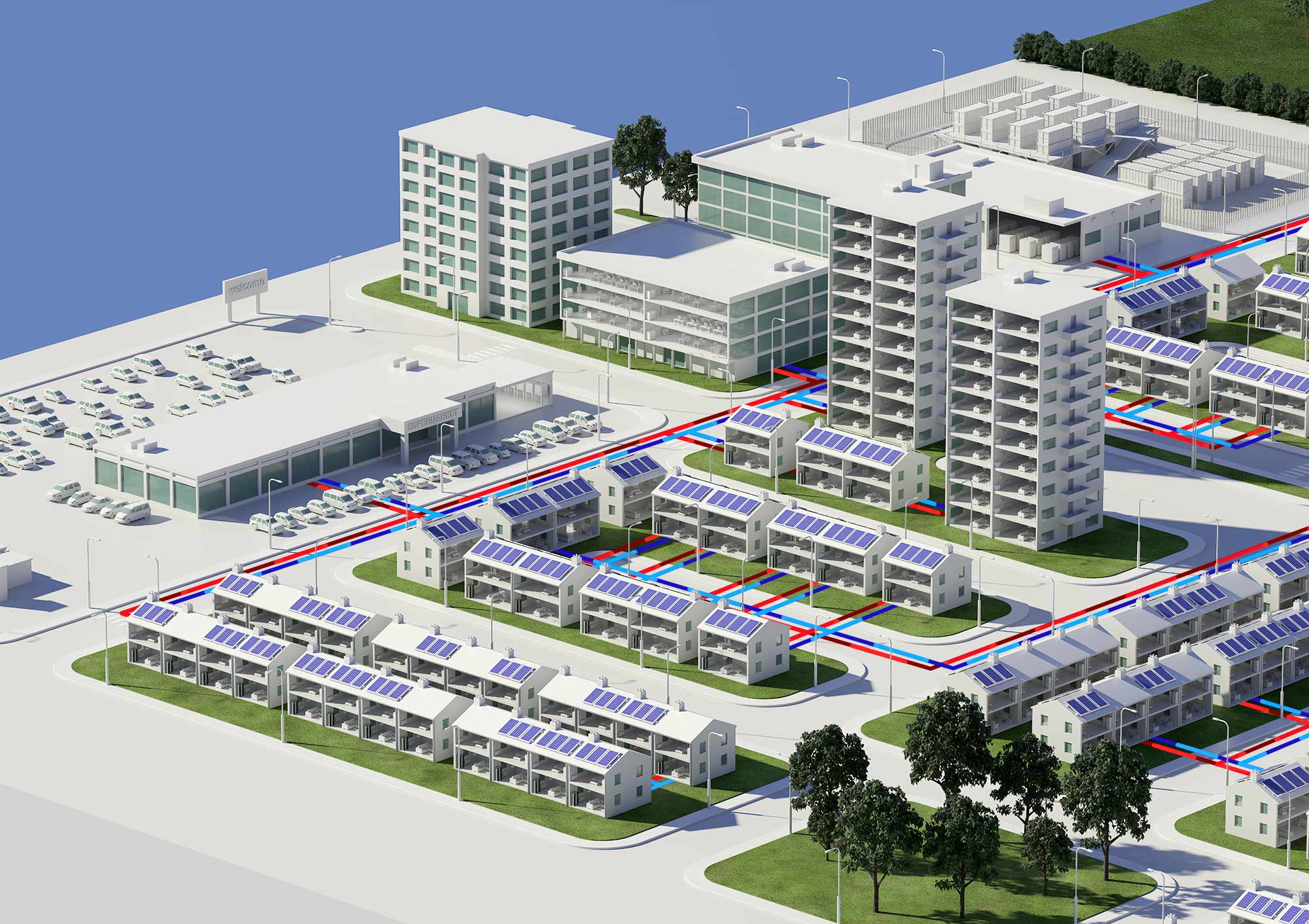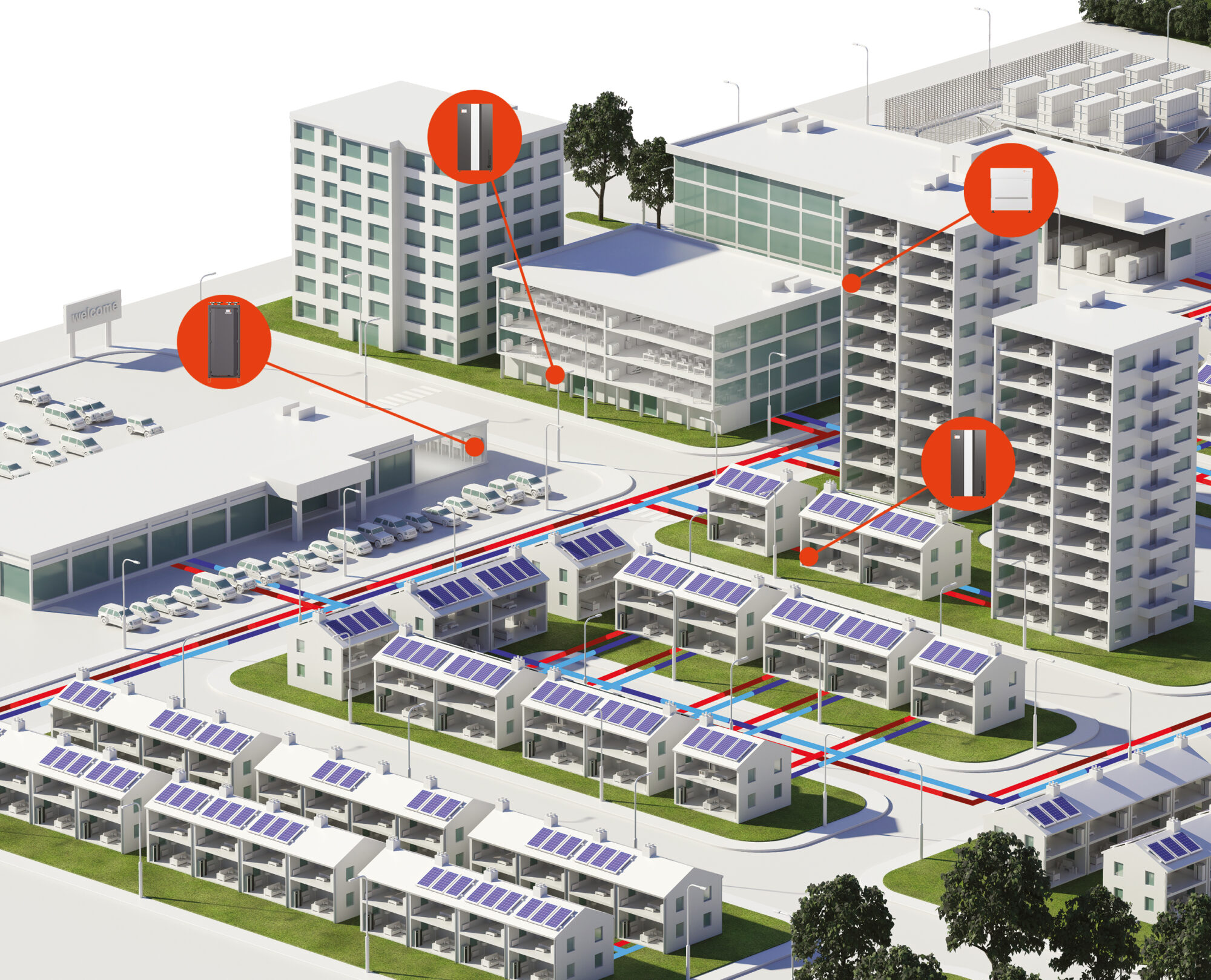Zoning entails identifying the areas which can be readily connected to a low-carbon heat network. Government is suggesting ‘local authority zoning’ as a roadmap to widespread heat pump deployment.
Kensa agrees that a phased approach is the most sensible way to roll out ground source technology, beginning with the areas with the most suitable geology, surface features, or sources of waste heat, as these are most conducive to lower-cost installations. It is encouraging that, refuting a common misconception that many properties won’t have space for the ground array, the government recognises that heat networks are suitable for densely populated towns and cities. This is also true of shared ground arrays.
Government is in the process of developing its heat network zoning approach but this misses the wider opportunity. There are several ways that heat could be decarbonised effectively and affordably, but if you attempt to make all methods and options available to all properties it would be extremely inefficient and costly. Instead, a more comprehensive strategy for heat zoning, as opposed to just heat network zoning, would enable the rapid and mass transition to zero carbon heating and cooling, in the most efficiency and cost-effective manner.
Local area energy planning (LAEP), a technique still in its infancy and without a formal role in UK policymaking, could provide the ideal vehicle for heat zoning the country. Increasingly English local authorities are taking the initiative and establishing their own LAEPs to provide a planned approach for how best to meet 2050 goals in their local areas. In Scotland, the production and implementation of such plans are already required by law, and the Welsh Government sees LAEPs as central to its heat decarbonisation strategy. It would be sensible for the UK Government to define a formal role for LAEPs, and support local authorities in their development and implementation, whilst giving the Future Systems Operator a coordinating role to bring these plans together.


The main contenders for heat decarbonisation
Under the concept of ‘heat zoning’, local authorities, through the development of LAEPs, would need to consider the most appropriate low-carbon heating technologies for their areas. The main contenders are:
- Change the gas type from natural gas to hydrogen.
This must be carried out on an area-by-area basis with all properties switching at the same time. Areas have or need a connection to a hydrogen supply (pipeline, liquified transport or local refineries).
- Install a high-temperature district heating system.
The infrastructure (low carbon heat source) and distribution pipework must be installed on an area-by-area basis and have a source for the low carbon heat (or a potential source if using gas as a bridging fuel).
- Install an ambient-temperature district heating system with networked heat pumps.
Again, the infrastructure must be deployed on an area-by-area basis and there must be a source (or more commonly multiple sources) for the low grade, low carbon heat.
- Install an individual heat pump e.g. Air Source Heat Pump (ASHP) or Ground Source Heat Pump (GSHP) in every property.
The only approach where decision making can be made at the property level. However even this approach needs area-based planning for the required grid upgrades and to mitigate concerns over noise and visual impacts.
The problem
It is illogical to assume that the infrastructure required for all four potential routes will be installed to all streets to allow complete consumer choice. If that were to be the case, we would have:
- The highest cost electrical upgrade designed to cope with the highest property level peak electrical demand (e.g. ASHP on the coldest day)
- New hydrogen infrastructure running alongside the existing gas infrastructure
- New highly insulated district heating pipework
- New ambient temperature pipework and energy source (boreholes)
All the above sized for 100% take up with companies vying for the consumer choice of their technology.
It is clear that any significant deployment of any given low carbon heat in an area weakens the case for the other options, even if they are the most suitable/lowest cost for that area. For instance, even an area with a relatively weak grid might support 25% of the properties having an individual heat pump (ASHP or GSHP). This would clearly reduce the investment case for conversion of the gas network to hydrogen – even if the area was otherwise suitable.
A far lower cost approach would be to zone the whole country and signpost the intention to focus on one of the above approaches in areas where they would be suitable.
For instance, hydrogen might be most appropriate adjacent to high temperature industrial processes. High temperature district heating most suited to the highest heat density city centres, ambient temperature district heating to lower heat density city and town areas and individual heat pumps to more rural/suburban areas with detached properties.
Once the most suitable heat decarbonisation route for a particular area is identified, property owners/consumers could be encouraged to follow that route using a combination of incentives.


The solution
- Perform high-level national and regional planning to identify regional constraints e.g. transmission grid capacity, proximity to industrial heat uses, favourable or unsuitable geology, availability and type of waste heat (e.g. energy from waste plant or data centre), gas grid capacity and remoteness.
- Create a tool kit for local authorities to perform more detailed local area analysis and plans.
- Ensure local authorities and consultants understand the potential heat decarbonisation routes and which options can be interoperable – for instance an ambient temperature network could source some or all its heat from a high temperature one, but it does not make sense to run both in the same street
- Local authorities produce detailed maps showing preferred heat decarbonisation routes for their whole area
- Incentives are introduced to encourage the preferred decarbonisation pathways
Potential consumer incentives
- Only allow subsidy such as the Boiler Upgrade Scheme or the Green Heat Network Fund to apply in the areas where they are subsidizing the preferred heat decarbonisation route
- Identify dates when existing gas provision will be withdrawn from various areas
- Ensure EPCs flag the correct potential heating upgrade for the area
- Revise stamp duty to encourage the uptake of the chosen low carbon heating system (and lower carbon buildings more generally)

Actions not recommended (or needed)
- Requiring consumers to connect. If the mapping exercise is carried out correctly then the recommended heat decarbonisation route would be the most advantageous for the majority of households and the majority will take that route – particularly once any incentives come into play. A small number “going against the grain” will not significantly affect the energy system as a whole
- Leaving it entirely to consumer choice. By definition, some of the most promising and lowest cost options can only be deployed on an area-by-area approach and these options would not be available to consumers. This would effectively restrict choices rather than facilitate them. Consumers don’t have a say in the gas or electricity networks that serve their properties.

Shorter term asks and heat network zoning
- Heat network zoning makes an active choice between high temperature and ambient temperature networks as part of the decision tree used to define a heat network priority area.
- Designation of heat network zones considers what heat density or property type is used to choose between high temp, ambient temp, or stand-alone solutions.
- Consultants and local authorities working on heat network zoning understand the ambient temperature option and how shared ground arrays feed into that.
Optimal heat decarbonisation pathway
Zoning of the whole country, and development of a nationwide map, would define the best strategy for effectively and affordably decarbonising each part of the UK. The industry is calling on the government to recognise that ground source heat pumps are the best low carbon heating solution available, and by providing the right support they can unlock the potential of shared ground array infrastructure, allowing the industry to rapidly and effectively scale up to reach the volumes needed to deliver 600,000 per year.







